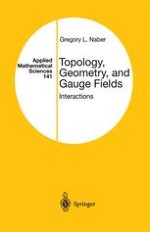2000 | OriginalPaper | Buchkapitel
de Rham Cohomology
verfasst von : Gregory L. Naber
Erschienen in: Topology, Geometry, and Gauge Fields
Verlag: Springer New York
Enthalten in: Professional Book Archive
Aktivieren Sie unsere intelligente Suche, um passende Fachinhalte oder Patente zu finden.
Wählen Sie Textabschnitte aus um mit Künstlicher Intelligenz passenden Patente zu finden. powered by
Markieren Sie Textabschnitte, um KI-gestützt weitere passende Inhalte zu finden. powered by
The plane ℝ2 and the punctured plane ℝ2 — {(0, 0)} are not diffeomorphic, nor even homeomorphic. There are various means by which one can prove this, but the most instructive among these detect the “hole” in the punctured plane (and none in ℝ2) by distinguishing topologically certain “types” of circles that can live in the two spaces. One way of formalizing this idea is to show that ℝ2 and ℝ2 — {(0, 0)} have different fundamental groups (see pages 112 and 140 of [N4]). Fundamental groups (and their higher dimensional generalizations) are notoriously difficult to calculate, however. In this chapter we will investigate another method of attaching to any smooth manifold certain algebraic objects which likewise “detect holes”. The idea is quite simple and, for ℝ2 and ℝ2 — {(0, 0)}, has already been hinted at in Section 4.4. There we found that any closed 1-form on ℝ2 is necessarily exact (Poincaré Lemma), but constructed a closed 1-form ω on ℝ2 — {(0,0)} that is not exact. Stokes’ Theorem implies that the integral of any 1-form on ℝ2 over any circle (compact, connected, 1-dimensional submanifold) is zero and the same is true of ω provided the circle does not contain (0, 0) in its interior. For a circle Sl that does contain (0, 0) in its interior (and has the orientation induced from ℝ2 — {(0, 0)}) we computed ∫ S lω and obtained 2π. The idea then is that the closed, nonexact 1-form ω detects the hole in ℝ2 — {(0, 0)} via its integrals over circles.
